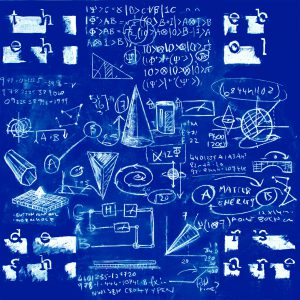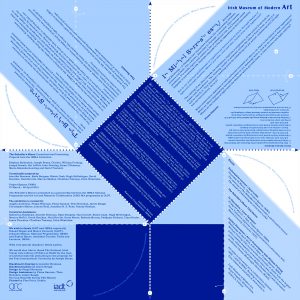The Beholder’s Share: Exhibition Texts
Exhibition invitation and brochure designed by Fergal Brennan.
Brochure design incorporates artwork by Jennifer Brennan.
Johanne Mullan, National Programmer, IMMA
We remember the definitions and differences between potential and kinetic energy from our scientific school days; kinetic to do with movement, potential to do with position or state. The water flowing down the waterfall as opposed to the water yet to fall. It is these ideas pertaining to energy that come to mind when reflecting on the notion of unrealised artworks and projects. The state or position of being unrealised involves that potential for action, for agency and in turn for realisation.
The Beholder’s Share brings together and celebrates the rich material that lies in unrealised projects and proposals. Including works that do not find their way easily into exhibitions, these rich artworks have been waiting in storage, being cared for, and inventoried.
Little known, some artworks are being displayed for the first time, others escaping a state of archival limbo, others unacted upon until the actors in this exhibition formulated plans for their realisation. The exhibition brings us to the top of the waterfall to see the cascade and the tumult and all its potential energy.
The Beholder’s Share marks a new development in the collaborative relationship between IMMA and IADT with the formation of the new ARC (Art & Research Collaboration) Masters. The partnership aims to encourage a discourse surrounding practice, that of the artist, the student, the curator and the museum.
IMMA wish to thank the artists and the students for bringing a fresh perspective to the Collection and drawing on their own research methods, documentation work and site specific responses. We would also like to thank IADT and in particular lecturers Sinead Hogan and Maeve Connolly for allowing IMMA the opportunity to share in this exciting development.
Theo Honohan
The Beholder’s Share examines unrealised and unexisting projects from the IMMA collection. The focus of the exhibition is the role that the viewer can play in imaginatively completing an unrealised work.
The phrase “the beholder’s share”, which was introduced by the Austrian art historian Alois Riegl and popularised by Ernst Gombrich, denotes that part of an artwork’s meaning which must be contributed by the viewer. The documentation of unrealised and in some cases impossible works in this exhibition is intended to provoke an exploration of this latent potential which exists even when the work itself does not.
In the years since the founding of IMMA, the building it occupies, the Royal Hospital, Kilmainham, and its grounds have been the site of sculptural proposals by Joseph Kosuth, Stephan Balkenhol and John Newling. Sol LeWitt and David Tremlett each proposed wall drawings for the chapel. Also in the IMMA collection are a ‘relic’ of an audio/radio work by William Furlong, and a proposal by Christo for an immense sculpture in the Texas desert made of oil drums, both speaking to ongoing global concerns about communication and energy. Archival documentation of Joseph Beuys’ proposed Free International University for Dublin, intended for the Royal Hospital site, brings to light a forgotten episode of Irish artistic and political history.
The work of the 4th year BA Visual Arts Practice students from IADT responds to LeWitt and Tremlett’s proposals as well as addressing personal and collective preoccupations in the form of unrealisable works.
Fiona Gannon
In Michel Serres’s essay Knowing and Believing – A Dialogue two characters discuss the relationship between science and faith. Pia, a doctor, describes to Pantope, a scientist, their interdependence. Pia needs rigour and reason in her professional life, and Pantope needs empathy in his personal life. Pantope responds to Pia by expanding on this interrelation:
But in our activities-professional or cognitive-we believe and we know, through flashes of light and through shadows. Haven’t you seen, now and then, beams from some lighthouse?
The casting of an idea towards its realisation requires a suspension of the actual from both its maker and its audience. The drawing, model or proposal allows the idea to find a form, to carry it and to clarify it. This becomes a meeting point for something not yet actual, something still thought but not encountered. Or is it?
When watercolour sketches of radio antennae transmit an idea to us, what is the status of that experience? When an idea’s impossibility becomes evident in our exchange with it, how do we come to that conclusion? Where do the flashes of light meet the shadows which ground them, or lose traction and sight entirely?
Download the exhibition brochure PDF here
Don’t forget to fold it…




